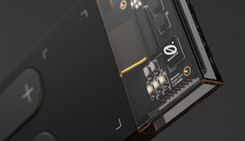Why ONiO.zero is perfect for Remote Controls


The very look and feel of the immediate world around us has been changing in a dramatic fashion - The very way our rooms look has been altered significantly thanks to the steady and sometimes radical evolution of technology. Advances in IoT technology have brought about irreversible changes to the way we interact with the objects that surround us. However, there’s one thing which has remained the same - take a look around you and see if you can spot it - the good old remote control.
The remote control is a piece of technology that has featured quite prominently in our lives for the better part of a few decades and yet, they haven’t really evolved much. They continue to largely look and function the same way they did 20 years ago. And what’s worse is that they continue to be powered by batteries, which in this day and age, just seem a bit out of touch.
No room for technological dinosaurs
Minimalism and conscientious consumerism are probably the defining trends of today’s consumer market. The discerning buyer of the 21st century isn’t just looking to acquire conveniences and status symbols - he is looking to create a tiny ripple of positivity with each purchase that he makes. He is looking to assert his core values with every cent that he spends.
The environment weighs heavily on the conscience of this modern-day consumer. The threat of ecological collapse and climate change is no longer the subject of abstruse classroom discussions - it is very much on the forefront of the global consciousness and this is more evident than ever in the kinds of products and services that consumers of today are favouring.
In this context, it is quite hard to explain the fact that the remote control is brazenly continuing in it’s boomer avatar - powered by AAs.
Think about it for a minute. How does this piece of technology compare to your smart AC, smartwatch or macbook? Something’s off right?
Minimalism seems to be the toast of the world today. To be brutally honest, the remote control wouldn’t really merit a place on any minimalist’s list of strictly essential electronics - Today, a smartphone can very easily replace a remote control - any remote control, let alone one that continues to be powered by batteries!
So, is there still a case to be made for a traditional remote control - Our guess would be that there is - but definitely not one that requires the user to remember to buy batteries every once in a while.
The battery problem
We have a gargantuan global problem with electronic waste or e-waste. The sheer volume of electronic waste that is generated year on year is enough to send most people into a headspin.
Batteries contribute to this problem in a massive way. Most modern day batteries contain one or more substances which are extremely problematic when it comes to safe disposal. Minerals like lithium and cobalt come with hefty environmental and humanitarian price tags that simply can’t be ignored.
In all honesty, as gruesome as it may be, batteries are not going away anytime soon. We simply don’t have any other viable option in a lot of cases. However, the case that is being made here is that we should definitely look to reduce our dependence on batteries and stop using them in cases where they are simply not the most elegant or viable solution available.
Batteryless is better
When it comes to remotes, batteries are no longer the most elegant power solution by a mile.
What is it then? Ahh….they must be cheaper? Oh those greedy……
Stop right there! No they aren’t cheaper either. This whole argument of ours rests on this two-fold premise of batteryless remotes, powered by ambient energy, being more advantageous for both the consumer and the manufacturer. Batteryless designs are significantly more economical than their battery-based counterparts - this is especially true with small devices such as remote control units which have very meagre power requirements
Energy harvesting technologies have truly created massive waves of disruption in the world of IoT and microelectronics. In fact, the rapid advancements made in various energy harvesting technologies are how we are able to make such an emphatic case against the use of batteries.
Energy harvesting in a nutshell
Energy harvesting operates on a pretty simple premise
There’s a lot of energy all around us right? Why not find ways to tap into this near-endless supply of energy and use some of it to power tiny devices?
It really is that simple. Make no mistake though - this simple premise has required immense work and countless brilliant minds to bring to fruition - but it still remains, in essence, one of those elegantly simple concepts that are characteristic of any sensible technology.
Today, energy harvesting technologies have matured significantly and are starting to feature prominently in commercial applications. Far from being gimmicky prototypes, they are actually viable for large-scale commercial use.
There are a number of energy harvesting solutions in the market today, including RF energy harvesting, piezoelectric energy harvesting, solar energy harvesting triboelectric energy harvesting, etc.
In fact, some clever scientists have even found ways to harvest energy from bizarre sources such as human sweat and wood.
So, what would a microelectronic system based on energy harvesting look like? Like, how would it work?
An energy harvesting-based remote control would have at its core a self-powered MCU that harvests ambient energy and stores small packets of it in a capacitor. This energy would be used to power the infrared emitter that sends the signals to the intended device - say your giant flatscreen TV.
The really cool part is that these sensors can actually use more than one means of energy harvesting - say, solar and RF - in case one isn’t practical at any given point of time, the other one kicks in, making for an uninterrupted user experience.
Savvy contender
ONiO.zero is our batteryless, general-purpose MCU - and if we may be permitted just a tiny bit of self-indulgence, the apple of our eye here at ONiO. We truly think this chip is awesome - get this - it harvests ambient RF energy and can be integrated into pretty much any kind of IoT device.
It’s a fully customisable power solution that fits neatly into whatever design your imagination can come up with and can power it for years to come with little to no need for any maintenance.
Let’s see how this would work in the context of a smart remote - The manufacturer would integrate ONiO.zero into the remote and then once shipped, the user will be able to use the remote control right away. And then, well that’s it really!
From the user’s point of view, there are exactly zero more things to do! The user can keep pressing on the buttons and the remote will, seemingly magically, keep doing its job. In the background, it’ll keep using ambient indoor lighting and RF waves (like wi-fi for example) to charge itself.
Pretty neat huh?
Serious Benefits
Let’s go about enumerating just a few obvious benefits that a batteryless remote control would bring to the table. Firstly, they will be cheaper to manufacture seeing as the manufacturer won’t have to include a battery hatch in the design. That may not seem like much, but over millions of devices, those precious few cents add up!
Then, there’s the added appeal to the user - “You don’t have to do anything at all” is a great proposition to make to your prospective customer.
And the best one of all is the fact that a batteryless remote, you guessed it, won’t include batteries - this means that it won’t have a sordid history of child labour behind it and it also means that it’s significantly more eco-friendly than a battery-powered remote.
The future
The future looks extremely bright for IoT technology. One of the major roadblocks that the internet of things has faced in its journey has been the battery bottleneck. Today, with energy harvesting technologies becoming accessible and affordable, the enormous expectations that IoT generated in its early days look poised to be realised.
Such a world can potentially be a dramatic improvement over ours in numerous ways - more connectivity can help us provide better healthcare, more environmentally sustainable goods and organise cities and towns in a more sensible way.
We believe that self-powered sensors are a huge landmark in the road to an IoT-powered future.












